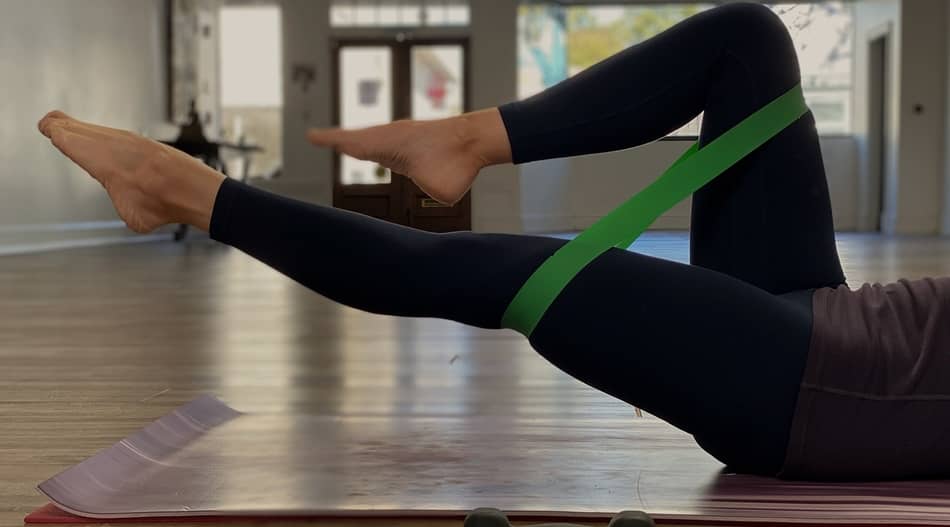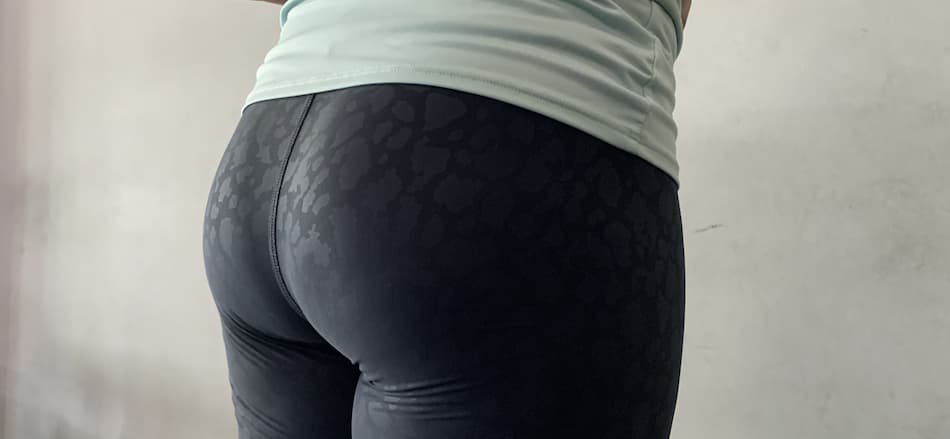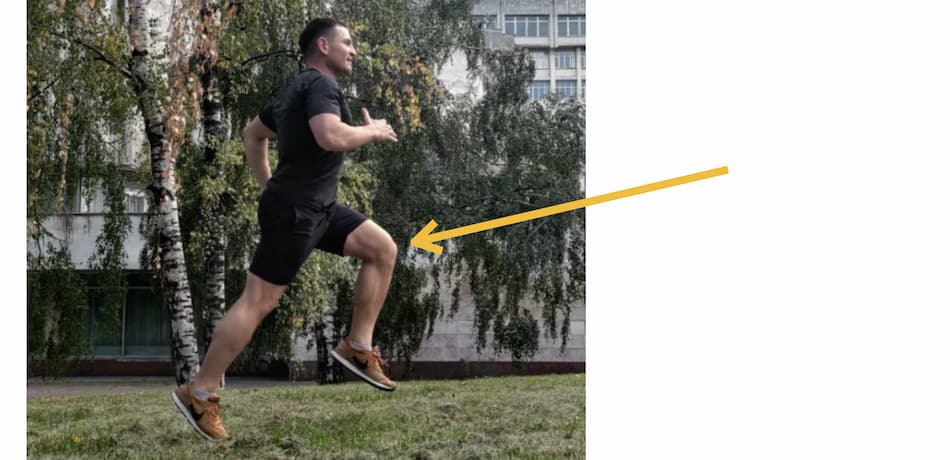Peloton has over 24,000 classes to choose from but only a few are focused on your glutes.
In this article, I will clarify if the peloton can work your glutes, what are the best classes and what is the optimal training volume to make your booty pop.
In general, the peloton does work your glutes because the bike classes require hip extension while being out of the saddle. Peloton rides, tread, strength, and Bootcamp classes all work your glutes, but to optimize your results you also need to spend time on glute activation.

In addition to the information on how you can activate your glutes on the peloton, please take a look at the workout recommendation.
I point out which ones you should focus on if your goal is to work on your booty.
Let’s Start From Glute Activation
The concept of glute activation started a while ago and was popularized by strength coach Mike Boyle.
Mike was the guy who first started to bring all the pieces together from the physiotherapy textbooks and implemented glute activation exercises prior to the workout.
Glutes are, Mike says, “one of the only muscles that require low-load activation prior to the workout.”
“The idea of spending 1-2 minutes to ensure the muscle is working within your warm-up helps not only to engage muscles more but also to prevent anterior hip pain,” Mike says.
What is glute activation?
In a nutshell, glute activation is not a workout. It works by engaging or “firing up” gluteal muscles before physical activity.
In glute activation, you’re not using the full resistance or peak contraction of the muscle.
Your goal of glute activation is to be able to engage your glutes more later during your primary workout.
Glute activation can be implemented during your dynamic warm-up in the form of certain light exercises to the point where you can feel your muscle working, but not to the point of exhaustion.
Glute activation is important for peloton classes
Peloton and glute activation exercises go hand in hand.
One of the biggest reasons why there is so much noise around having strong glutes is because it helps not only reduces lower back pain during the exercises but also helps to reverse certain postural adaptations.
Here’s how it works.
- Prolonged sitting leads to muscle tightness and shortened position (especially in the hip flexor muscles). This is called adaptive shortening of the hip flexors.
- Shortening of the hip flexors leads to reciprocal inhibition of the glutes, which is a fancy name to describe that your glutes are relaxed, down-regulated, or deconditioned.
- Since the glutes are deconditioned, the hamstring and adductors need to work extra to pick up the slack for inactive glutes.
- This concept is called synergistic dominance, which can lead to overworked muscles, strain, and injury.
Glute activation helps to generate more power output
One of the reasons why I always spend 1-2 minutes before my peloton workouts on the floor doing glute bridges is becasue active glutes make the peloton rides easier.
- Active glutes help to develop a lot of force, power, and speed.
- On the other hand, if you don’t have your glutes engaged during the ride, you can miss out on a lot of potential power from your hip.
Plus, your glutes also take the pressure from your lower back, especially when you’re leaning on the bike in the standing position.
If you do a lot of peloton climb rides, HIIT, or Hill classes, without glute activation your lower back takes in a lot of stress.
Glute activation helps to stabilize the hip
Glutes are doing a pretty good job in the stabilization of the hip, which then carries on into the stabilization of the knee and the ankle.
This has also a massive effect on the lower back and the degree how much your lower back muscles get involved.
- When the glutes are not fired up properly, they destabilize the hip and the knee.
- This creates more pressure on the quads and hamstring because they have to work more not only to develop a force during the high cadence but also to stabilize the joints.
Active glutes help to extend the hip and keep your back safe
Hip extension happens when you’re standing up on your bike like in peloton out of saddle classes.
When the glutes are inactive, the lower back takes an enormous amount of pressure each time you try to straighten yourself up. If you do classes every day, over time this can lead to lower back pain.

I like to think about the glutes as the powerhouse of the body. Not only do they look saucy but also they help with stability and general movement.
What happens when your glutes aren’t active?
When you won’t activate your glutes, your body will start to use different muscles (e.g. hamstrings, adductors). Think poor performance, hip instability, and muscle compensation.
Glute inactivity refers to pattern adaptation of the gluteal muscle.
Let me explain.
- One of the reasons why we have poor glute activation in the first place is our lifestyle.
- Being stuck in a biomechanically insufficient position (e.g. sitting) for an extended time reinforces a habit of putting glutes in an inactive position where they cannot contract.
- The body learns this and recognizes it as a pattern.
- Over time this leads to muscle weakness and hip instability.
When glutes are “switched off” because of the way they are positioned, they are inactive, cannot contract optimally and the body has to rely on supporting muscles to do their job for them.
When your glutes are shut down, it’s easy to rely on other muscle groups.
My point is that you want to build this habit of using your glutes instead of relying on the hamstring, quads, and lower back.
This will take time to get used to it.
Peloton doesn’t have glute activation classes
Overall, peloton does have over 100 different warm-ups in their workout library, but they do not have any glute activation classes.
Unfortunately, most of the peloton warm-up classes work on full body and help to increase resting heart rate. These are not the glute-specific drills that help to activate the muscle.
No problem.
I will show you a simple peloton glute activation routine you can do before your rides or classes to help you fire up glutes properly and make sure you’re using them correctly.
How to activate glutes before peloton rides
- Pick up a low-intensity exercise (glute bridges, single-leg glute bridges, banded sidewalks, frog pumps).
- Perform the exercise with almost no resistance but a relatively high volume (multiple repetitions).
- Instead of focusing on doing fast and rapid moves, slow down.
- You don’t need to count repetitions but you want to continue to do the exercise until you feel the light burn in the muscle.
- As you continue doing reps, focus on squeezing the butt throughout the exercise. This will allow you to develop body-mind connections and establish neurological pathways.
- The neurological pathway is basically creating a new pattern adaptation where you build a new habit of keeping the glutes active.
- The more often you do it, the body will get to the point it will fire up glutes permanently.
Glute activation is important because it helps to use the muscle more efficiently during the peloton rides, correct dysfunctional moves, improve hip stability and reduce muscle compensation.
It also helps to build more functional and better-looking glutes.
How to activate glutes before peloton using bands
Here you can see an example of the glute activation exercise from Bret Contreras, Ph.D., also known as the Glute Guy and the inventor of the barbell hip thrust exercise.
The goal here is not to create a huge muscle contraction, but to continue squeezing the butt while doing the movement until you can feel the muscle working.
This is my favorite exercise becasue it does not require you to use any equipment.
You can literally lay done on the floor next to the peloton and perform frog pumps. For better results, you can use glute loop bands.
How long should you activate your glutes before peloton classes?
In general, you should not spend more than 5 minutes for glute activation prior to peloton wokrouts. I recommend doing that together with your dynamic warm-up.
Remember, this is not a workout.
Glute activation exercises are much different from regular squats, lunges, or deadlifts. It’s a tool that helps you use your glutes better and takes the pressure off your lower back.
Can I activate glutes on the peloton bike?
In general, you cannot activate your glutes once you’re on the bike. Technically, you can squeeze your butt when you stand (aka mind-muscle connection) but that does not stimulate the muscle.
When you’re in the peloton saddle your legs are moving in a single plane which makes the body rely predominately on quads and hamstrings.
You need to activate them when you’re off the bike. This helps to fire up and establish neuronal pathways so when you’re back on the bike, you get better results.
Related article: Best peloton classes for beginners
Is Peloton Good To Build Strong Glutes?
Building strong glutes is not only important from the visual perspective, but also from the functional.
Fortunately, you can develop a bikini booty with a range of classes available in the peloton app.
Most of the peloton strength classes, cardio HIIT, running, and peloton ride all call for glute activity, and if your goal is to build a strong-looking backside, here are some of the best options to choose from.
Peloton glute classes will make your glutes bigger
Does peloton make you glutes bigger?
Yes, a peloton does make your glutes bigger, as long as you do enough weekly training volume and spend time before your workouts to activate the muscle.
Several peloton workouts are glute-oriented and can help you increase your strength as well as achieve optimal hypertrophy.
Best Peloton bike rides for glutes
Peloton offers over 9,000 cycling classes, but the majority of them are in the saddle.
This is great for cardio, weight loss, and muscle endurance, but not for your glutes. Being in the saddle inhibits glute activation and puts more pressure on the quads and hamstrings.
Glutes are the most activated when you are out of the saddle.
That’s where you recruit the most power from your hips, so if your goal is to build strong glutes, here are the 5 classes I recommend you try.
1. Climb Ride
Climb ride is a series of classes that require constant moving in and out of the saddle. That is like dream come true for your glutes because they are constantly firing up.
There aren’t many classes that work just in the standing position, but the Climb Ride is close enough.
You want to spend as much time standing as possible. This will challenge your glutes by constantly extending your hip.
My best pick is a 45-minute Climb Ride class with Erik Jager (German-speaking). I don’t understand the german language, but his class is all about standing.
2. HIIT and Hills
HIIT and Hills are similar to climb classes because it requires you to stand out of the saddle for a good period of time.
However, it also has that extra mile component of interval training. Interval training helps you to not only focus on the glutes but also get your heart rate elevated.
My best recommendation is a 45-minute HIIT and Hills Ride with Ben Alldis. He does lots of moving around and I like his spring intervals out of the saddle.
3. Bike Full Body Bootcamp
This class helps you go one notch further because it adds more weight to the workout. Peloton bootcamp classes combine ride together with weight training.
One of my favorites for glutes is full-body bike bootcamp. This class gets you on the bike for 5-7 minutes, and off the bike for 12 minutes doing full-body exercises.
My best pick is 60 minutes advanced full body Bootcamp with Jess Sims.
Best Peloton classes for glutes (without the bike)
Next, I wanna show you the best peloton classes without the bike that also focus on your backside. glutes off the bike.
Currently, there are over 10,000 non-bike classes on the peloton, but only a few are glute-oriented.
Here are my best picks.
4. Glutes and Legs Strength
Peloton glutes and leg strength is a huge selection of lower body exercises, predominately focused on your glutes. Those workouts can be done either by themselves or in combination with peloton rides.
From over 200 lower body workouts, I personally recommend the 30-minute Glutes and Strength class by Chase Tucker.
Chase is not with the peloton anymore, and despite what people say about rating and all, I still think his classes were awesome.
His classes include several lunges, side lunges, squats, and deadlifts. Adding heavier weights makes a huge difference.
If you wanna focus mainly on your glutes, I recommend doing 3-4 glutes and leg strength classes per week.
5. HIIT Run
If you like running then peloton HIIT Run is a pure gold mine for glute activity. In general, running at a slow pace engages predominately your gastrocnemius-soleus complex and quads.
However, sprinting is different.
Running at a faster pace gives you the most glutes activity because of the greater hip flexion.
- To run faster, you change your biomechanics.
- You need to swing your leg further and lift your knee higher to maintain a fast pace.

- This change engages your glutes most efficiently.
My best recommendation for the class is to try a 20-minute advanced HIIT Run with Becs Gentry.
She keeps the pace high, pushes you to go all out, and gives you enough time during the recovery walk to catch your breath.
6. Interval Run
Peloton Interval Run is another variance of interval training. Here, instead of going hard for 60 seconds with a 60-second rest, you basically run fast for 60 seconds, followed by jogging for 60 seconds.
The number of rounds will depend on your fitness level.
If you like running, then you can really develop strong-looking glutes simply by shifting more towards the intervals instead of a steady pace race.
My best recommendation is to go for a 20-minute advance Interval Run with Becs Gentry.
7. Uphill Walking
This one is underestimated, but the most effective low-impact glute builder (my wife likes this class the most.)
Several studies have shown better gluteal muscle activity using electromyographic (EMG) during uphill walking, compared to flat-level walking.
Here is the graph from the study published by Jason R. Franz, Ph.D., a researcher from the University of North Carolina Chapel Hill.

(Image source: Gait & Posture Journal 2012)
You can see from this graph above that as soon as you add incline to the treadmill, the glute activity goes way up.
My point is that peloton walking classes that use steep elevation can make a huge difference.
A good glute activity you can get from as low as 5% incline. I don’t recommend adding speed.
Just work on an incline.
You can walk outside, too
Thankfully, you don’t need to get a peloton tread to be able to walk uphill.
If you live in a place with hills and mountains, go outside and walk uphill. If you don’t, find a place with a steep staircase and walk up and down.
This will activate your glutes and can be done on your days off, as a part of your active recovery program.
8. Barre
Another great booty class is the peloton barre workout. This workout is a combination of ballet fitness, yoga, pilates, and calisthenics.
I personally do not do a lot of peloton barre (although my wife is a full fan. She like the Ally Love 10 minutes classes).
It’s not a secret that barre is a perfect workout for your glutes (just look at the glutes of some dancers).
This workout is all about high reps and low impact. Obviously, this is not the best peloton class for weight loss (for that you need more intensity), but I think it’s a killer workout for your glutes.
Here you will get to do many lower body exercises like kickbacks, fire hydrants, donkey kicks, leg extensions, side extensions,s and much more.
Conclusion
- If your goal is to develop strong-looking glutes, your number one goal is to spend some time prior to your class on glute activation.
- After that go ahead and choose the class that is specifically designed to work on your hip extension and target the glutes.
- This establishes neuronal pathways in the brain that when reinforced over and over again helps to keep the glutes engaged.
